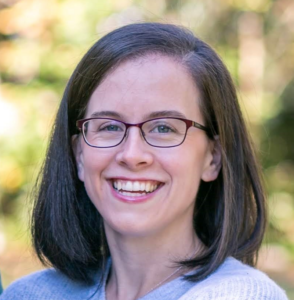Courtney Chaaban ‘11 is a Ph.D. candidate within the Human Movement Science Curriculum at the University of North Carolina at Chapel Hill — a joint program offered by the Department of Allied Health Sciences, UNC School of Medicine, and the Department of Exercise and Sport Science within the College of Arts & Sciences. She is the recipient of the Tom and Karen Sox Summer Research Fellowship, which will allow her to continue researching adolescent anterior cruciate ligament (ACL) injuries and treatment.
Support graduate students like Courtney
Q: Tell us about your research.
While I was working clinically as a physical therapist, I noticed there were some disparities from my previous work in a university setting. When I worked outside the clinic as a physical therapist, I didn’t have a lot of the same tools that were previously available to me; I couldn’t put patients into the same environments they’d encounter once they got back to sport. A lot of the time, an athlete tears their ACL when their attention is not directed at what their knee is doing, but we don’t ask them to do that in rehab. We say, ‘jump and think about jumping,’ not, ‘think about players coming at you and having to make this play.’ The goal of my research is to help put athletes in these situations they’re going to encounter, and then be able to measure what exactly their knee is doing when they’re in those situations.
Q: What does this summer funding mean to you, and what will it allow you to do?
It is incredibly helpful. The good news for me in doing research on adolescents is that they have the most free time during the summer. So, in terms of just being able to recruit participants, it’s very helpful to have dedicated research time to focus on my project while my participants are most available. It also gives me time to focus on my project without other commitments like teaching which I’ve done every other summer.
Q: Can you tell me about your background, and what led you to this field of study?
I attended UNC-Chapel Hill for undergrad. In my first year doing gymnastics, I tore my own ACL. I had great athletic trainers and physical therapists that I worked with but still had a really hard time getting back. I ultimately decided to give up gymnastics, but I became interested through the care that I had received.
Q: What led you to study the cognitive aspect of ACL injuries?
I think biomechanics is something that has been fleshed out a lot over the last 15 or 20 years, and despite paying a lot of attention to biomechanics, we’re not seeing drastic improvements in how people are doing. This led people to think: ‘what are we missing here?’ I think of biomechanics as the output; that’s what your body is doing. But we need to pay attention to why it’s doing what it’s doing, which is how I became more interested in the cognitive aspect as well.
Q: What brought you to UNC-Chapel Hill?
Carolina is sort of a family affair for me. My parents met at UNC-Chapel Hill as undergrads; my brother, sister, and I all attended Carolina for undergrad. … I love the university, and I love Chapel Hill. But the number one reason for coming back was definitely my advisor, Darin Padua. I loved the experience I had with him in undergrad and felt like there was nobody better to guide me through the Ph.D. experience.
Q: Once you complete your Ph.D. what would you like to do?
That’s a great question. I have lots of options right now. One would be to go on and complete a postdoc. A lot of my training has focused on biomechanics and what the knee does, but I would like complementary training on what the brain does and how we can better incorporate the cognitive aspect into rehab, then hopefully get a physical therapy faculty position after that. The other option is potentially going into industry. Right now I’m between the two.
—Kate Slate
